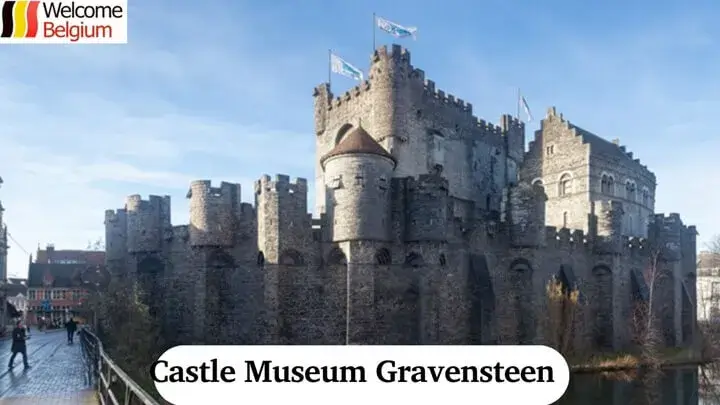It is impossible to imagine a trip to Flanders Belgium without visiting the famous Gravensteen Castle. It is located in the city of Ghent and is a local historical landmark. This is the only structure in the region whose defensive lines and buildings remained intact. You should definitely visit here, see the collection of torture instruments, and learn the history of this building.
How the castle was created
In the 9th century, the local residents of this region suffered from the Viking invasion. Therefore, Count Baudouin I the Iron Hand decided to build a defensive complex for a garrison of soldiers. The main building was located on a hill, which simplified defense. Around Gravensteen Castle there were small wooden buildings designed to store food supplies, weapons and serve as a place of residence for peasants.
This approach made it possible to reduce the number of raids. Therefore, later the rulers began to carry out reconstructions and expansions of the defensive complex:
- 1180 Count Philip of Alsace increased the area of the main throne room and erected walls with 24 defensive towers. This was done to show the nobility located on the other side of the Leie River their greatness and power.
- XIV century. The castle ceased to be the main residence, since, in the opinion of Count Louis II of Male, its level of luxury and comfort did not meet the requirements. However, official meetings and meetings were periodically held here.
- Since 1353, this place has become the state mint. A little later, in 1407, the supreme court of the county operates in Gravensteen Castle.
- Since 1778, buildings and structures of the defensive complex began to be sold to everyone. Gradually the castle fell into poor condition.
In the 19th century, the local council decided to reconsider the significance of the Gravensten residence for the city. Gradually they began to buy it from private ownership, and reconstruction was carried out. It was led by the architect Joseph de Vale. He managed to return the castle to its original appearance, which was under Philip of Alsace. The completion of the work took place only in 1980, when Gravensteen Castle was opened to visitors.
Interesting: since 1807, the area was used as a textile factory. The workers lived in outbuildings.
Museum overview
A special feature of the Gravensten Castle Museum is that you can see the original defensive structures – ramparts, a fortress wall with towers, a residence, and a large gate. To attract tourists, thematic routes and excursions have been created. Here you can see household items, weapons and knightly armor. This is important for understanding the culture of the Middle Ages and the Renaissance.
What does the museum excursion program include:
- History of torture. The Counts’ Castle houses a unique collection of torture instruments, presented in the original executioner’s cabinet. The former storage room has been transformed into a sombre exhibition, and the courtroom houses a collection of forensic items. Various cultural events and activities take place here. This is a favorite place for locals to hold wedding ceremonies.
- Symbols of power and authority. The history of the castle dates back to the era of Roman rule, when the first settlement arose on the sandy banks of the Lys River. After the Viking invasions, the counts of Flanders built a stone fortress here with a donjon and 24 towers to protect against raids. The castle’s massive walls and defensive architecture still inspire respect and remind of its former greatness.
- Gift shop. You will not be left without a memorable gift or souvenir. Miniatures of the castle, thematic literature, copies of historical objects. This can be purchased at your local gift shop.
Want to add a little fun to your visit? Take an audio tour narrated by Flemish comedian Wouter Depre. His story is full of humor, unexpected facts and exciting stories about medieval knights. The tour is also accessible for people with hearing impairments – a video guide in Flemish or an international language guides you around the castle, and a tablet with 18 videos is included in the ticket price and is available in the castle shop.
Important: the opening hours of the Gravensteen Castle Museum are from 10:00 to 18:00. You can find out detailed information on the official website.
How to get to Gravensten
The historical museum is located at Sint-Veerleplein 11, Gent, Belgium. You can get to Gravensteen Castle by bus, tram, taxi or car. For the latter, we recommend using car rental services in Ghent. This will allow you to see other local attractions without being tied to city public transport.
Public transport routes to the historical museum:
- No. 3, No. 17, No. 38, No. 39. Tickets can be purchased from drivers or at the ticket office at the bus station.
- No. 1, No. 10, No. 11, No. 12, No. 13, No. 40, No. 42.
- The fare depends on the point of departure. From the center of Ghent it does not exceed 60-70 Euro.
All public transport stops in front of the main gate of the museum. Here you can purchase tickets, book a group or individual tour of Gravensteen Castle. Don’t forget to buy souvenirs and take photos to remember your visit to this historical museum in Belgium.






